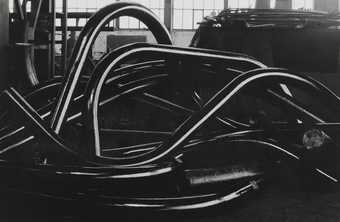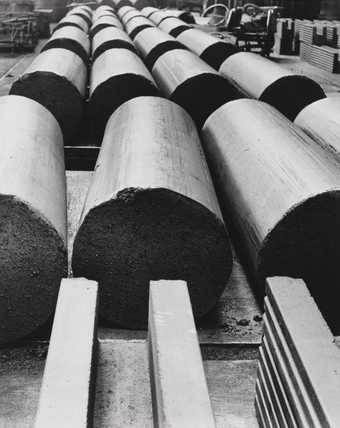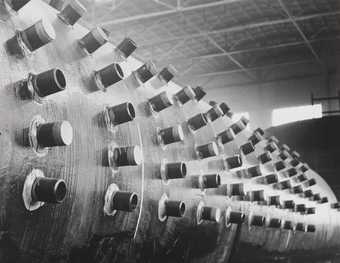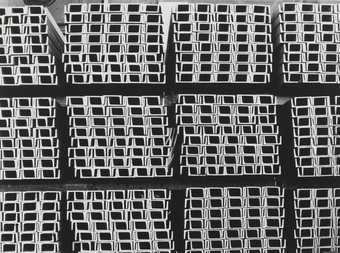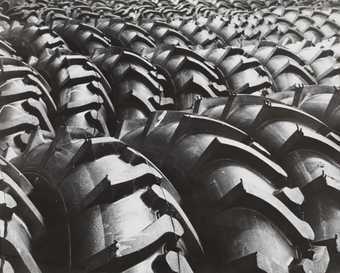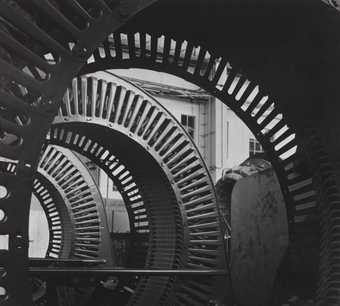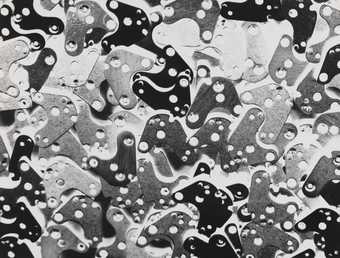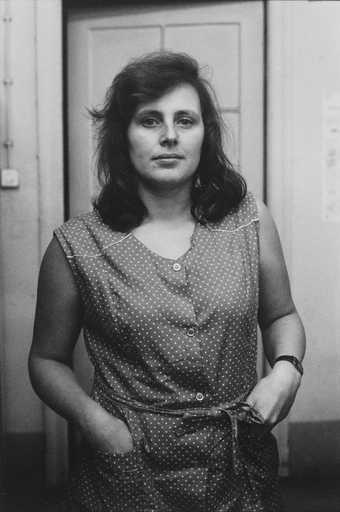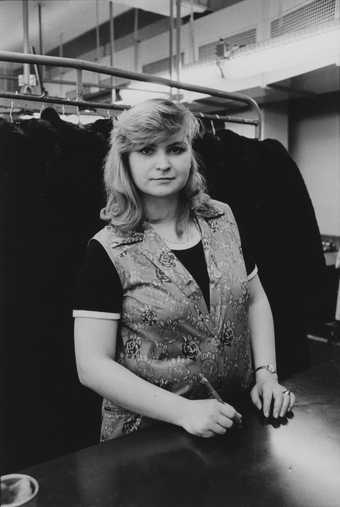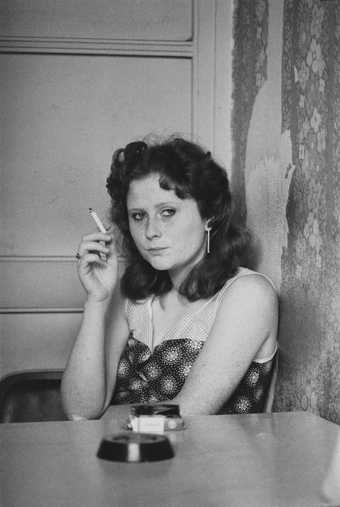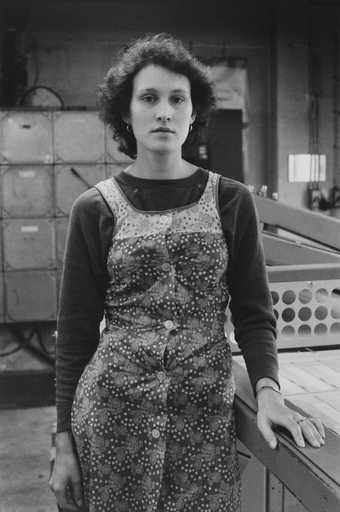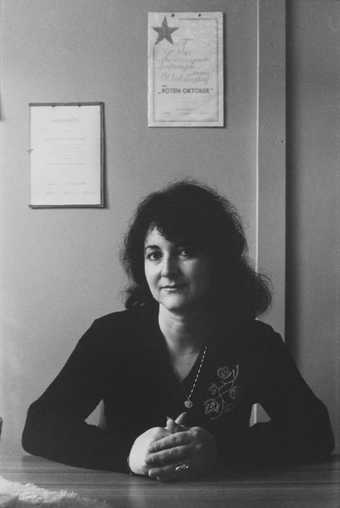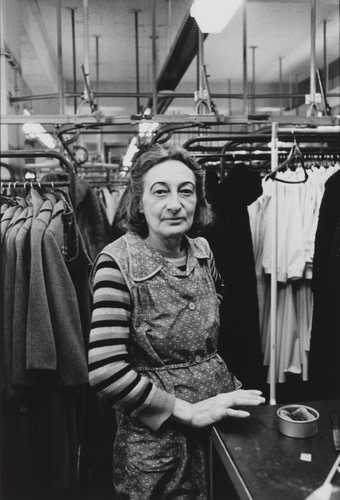
In Tate Liverpool
- Artist
- Tadeusz Suminski 1924–2009
- Medium
- Photograph, gelatin silver print on paper
- Dimensions
- Image: 176 × 221 mm
- Collection
- Tate
- Acquisition
- Purchased with funds provided by the Artworkers Retirement Society (Tate Americas Foundation) 2014
- Reference
- P81092
Summary
This is one of nine small black and white silver gelatin photographs in Tate’s collection by the post-war Polish photographer Tadeusz Suminski that were taken in Polish factories. They come from a larger body of work made between 1962 and 1964 for an assignment on new industrial complexes in Poland; Suminski later selected certain images such as these to develop and print privately for inclusion in exhibitions and competitions. The photographs feature closely cropped details of machines and mass-produced industrial products arranged in careful compositions that verge on abstraction. By focusing on serial patterns and contrasts of light and shade, they draw attention to the potential for beauty inherent in the machine-made, industrial environment. The works are titled descriptively according to the factory in which they were taken and the material or machine they depict. Tate’s prints are vintage prints, acquired from the artist’s estate.
Suminski’s previous assignments as a photojournalist for the monthly publication The Polish Review had varied from illustrating essays on agriculture to documenting meetings with foreign diplomats. However, overwhelmingly, industrial motifs came to dominate the reports published in the magazine. Industrialisation had become a key priority for the Polish government: in the wake of the material and economic devastation caused by the Second World War, initiatives were put in place to rapidly industrialise the country, advance heavy industry and boost the economy. State funds during the 1950s were channelled into the construction of factories, chemical plants and shipyards.
Between 1962 and 1964 Suminski was dispatched by the magazine to document a number of factories across Poland and to supply imagery to illustrate written reports on these newly built industrial complexes. From the photographs Suminski delivered, ideologically loaded images of workers operating machinery were usually selected by the editors for publication in the magazine. However, his private photographs from this period – such as the ones in Tate’s collection – offer an alternative approach to photographing industry that explored the formal properties of the products, materials and machines in the factories he visited.
Devoid of human presence, the photographs isolate, frame and focus attention on details of machinery and equipment photographed from unusual perspectives. These images are alternated with clearly and precisely rendered studies of serially produced industrial products in which the horizon line is blocked out to eliminate any sense of perspective and bring the images to the threshold of abstraction. In contrast to the propagandistic use of photography in the Polish popular press of the time, in these images narrative content is suppressed in favour of a concentration on pattern and form. Suminski’s work of the 1950s and 1960s stands in stark contrast to his later career, in which he took up landscape photography and created romanticised picturesque views of rural scenes.
Further reading
Tadeusz Suminski, ‘Photography and About Myself’ (Uber Fotografie und uber mich selbst), Fotografie, no.12, 1968.
Marta Przybylo-Ibadullajev, Tadeusz Suminski: Factory and Form (Tadeusz Suminski: fabryka i forma), Warsaw 2010.
Nicolas Grospierre, Tadeusz Suminski: The Picture which Grows (Nicolas Grospierre, Tadeusz Suminski: zdjecie, które rosnie), Warsaw 2011.
Sabina Jaskot-Gill
July 2011
Does this text contain inaccurate information or language that you feel we should improve or change? We would like to hear from you.
You might like
-
Tadeusz Suminski Tubing, Racibórz Boiler Factory
1962 -
Tadeusz Suminski Electrodes, Racibórz Boiler Factory
1962 -
Tadeusz Suminski Racibórz Boiler Factory
1962 -
Tadeusz Suminski Profiled Steel, Pafawag
1962 -
Tadeusz Suminski Tyres, Debica
1963 -
Tadeusz Suminski Generators, Wroclaw
1962 -
Tadeusz Suminski Watch Parts, Blonie
1962 -
Tadeusz Suminski Cigarettes, Czyzyny
1962 -
Helga Paris Women at the Treff-Modelle Clothing Factory
1984 -
Helga Paris Women at the Treff-Modelle Clothing Factory
1984 -
Helga Paris Women at the Treff-Modelle Clothing Factory
1984 -
Helga Paris Women at the Treff-Modelle Clothing Factory
1984 -
Helga Paris Women at the Treff-Modelle Clothing Factory
1984 -
Helga Paris Women at the Treff-Modelle Clothing Factory
1984 -
Helga Paris Women at the Treff-Modelle Clothing Factory
1984

